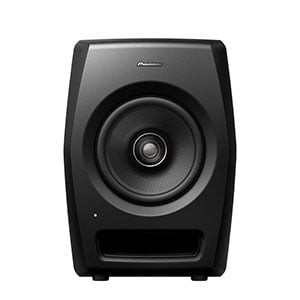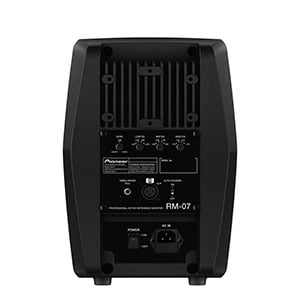- Home
- Instruments
- Gear
- Recording
- Lessons
- Reviews
- Blog
While Pioneer is perhaps best known for quality DJ-centric audio equipment such as turntables, headphones and mixers, the Japanese brand has certainly proved capable of producing an active monitor that people want to use! The RM-07 coaxial speaker is a little unconventional, but certainly gives other monitors in the sub-$1,000 market a run for their money. Let’s take a closer look at the RM-07.

It’s safe to say that the RM-07 is not the best-looking speaker in this market, although it’s by no means bad. Standing at just under 10” tall, and with a sleek brushed matte-black finish, it features a slightly bulbous shape that’s carrying a little extra weight in the middle – like the fat little brother of some other speakers in this category. While its appearances may not be to everybody’s liking, the RM-07’s strengths are undoubtedly in its construction, with a sturdy, non-resonant die-cast aluminum cabinet that’s built to withstand pretty much anything. This robust construction is reflected in the weight (around 27lbs). It’s a hefty little speaker!
Around the back you’ll find both unbalanced RCA and balanced XLR inputs, as well as a rear panel that offers gain control and simple 3-band EQ (low, mid and high) controls. There is also a power-saving ‘auto standby’ switch, which shuts the system down after around 20 minutes of standing idle.

The driver design is another aspect that gives the RM-07 quite a distinctive appearance. This is a single, compound driver that puts the 1.5” Hard Dome aluminum tweeter and 6.5” Aramid fiber woofer on the same axis, offering a large sweet spot. The tweeter also features an upturned skirt, which increases its rigidity, allowing the frequency response to reach 50kHz. Meanwhile, the active crossover between the two drivers is a low 1.6kHz.
Inside the cabinet is an acoustic tube and bass reflex port, known as ‘Acoustic Filter Assisted System Tuning’ (or AFAST) technology. This promises clarity and a high-definition sound, with an improvement in low to mid-range response.
As with others on our list, the RM-07 is a critical listener’s monitor, offering a very flat response with great clarity and separation. While flat, there is still life in the sound and monitoring on it feels vivid and ultimately enjoyable. There feels like a little more warmth than some others in this price range. For such a small speaker, the overall power and depth in sound is mindboggling! However, thanks to its rigid build, the cab resonance is kept low even at high volumes and you will find it is very hard to distort this speaker.
he sub-$1,000 studio monitor market is a crowded one. However, thanks to its hefty power, true sound and reliable build, the Pioneer RM-07 is certainly a big contender – unless you really can’t get over the slightly squat design (and in that case we recommend you close your eyes!).
For more info about the Pioneer RM-07, click here.
For more Studio Monitors Under $1000, click here.

Reader Interactions